搜全站
搜展位
解决方案
六种不同文库制备试剂盒用于 FFPE 样品外显子序列捕获应用的比较
应用领域
生物产业检测样品
其他检测项目
外显子序列捕获外显子组测序和靶向基因组合测序是常用的新一代测序 (NGS) 方法,用于鉴定和表征科研与临床样品(如癌症样本)中的不同基因突变。基因组合靶标设计、实验室处理操作和生物信息学分析等许多因素都会影响变异/畸变检测的灵敏度和准确性。本文展示相同 FFPE 样品在多个供应商的六种不同文库制备试剂盒中得到的对比结果。在 100X 原始测序深度下,Agilent SureSelectXT HS 文库制备试剂盒在四个关键指标上表现出最佳性能,即在靶率、平均读出序列深度、20X 读出序列深度下的靶标碱基覆盖率以及捕获前文库产率。供应商 A 试剂盒在 20X 读出序列深度下的靶标碱基覆盖率和捕获前文库产率两个指标中排名第二;供应商 E 在在靶率和平均读出序列深度两个指标中排名第二。总体来说,Agilent SureSelectXT HS 试剂盒的性能优于评估的其他 5 种试剂盒。

共1台
使用液质联用系统分析未衍生化氨基酸的方法——用于食品、生命科学和代谢组学应用
应用领域
生物产业检测样品
其他检测项目
未衍生化氨基酸本应用简报介绍了一种针对未衍生化氨基酸分析优化的方法。氨基酸的极性使其难以进行反相液相色谱分析。然而,亲水相互作用色谱 (HILIC) 能保留并分离复杂的氨基酸混合物,同时还具有与传统反相色谱类似的工作流程。HILIC 与质谱的组合提供了一种简单而功能强大的氨基酸分析解决方案。
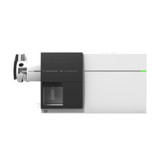
共4台
使用 HILIC LC/MS 对哺乳动物细胞培养基进行监测
应用领域
生物产业检测样品
其他检测项目
养分吸收和分泌废物将 Agilent InfinityLab Poroshell HILIC-Z 色谱柱与 Agilent 6545 Q-TOF LC/MS 结合使用,对六天内采集的哺乳动物细胞培养基中的养分吸收和分泌废物进行监测。HILIC-Z 色谱柱可保持良好的峰形与保留时间重现性,能适应高盐样品(如细胞培养基)。该方法通过优化流动相、梯度和仪器参数,可用于在负离子模式下的单次分析运行中对生长培养基的养分(即葡萄糖和氨基酸)与代谢废物(即乳酸及 TCA 循环相关的其他有机酸)进行监测。

共4台
重组蛋白表征——氨基酸分析
应用领域
生物产业检测样品
其他检测项目
氨基酸分析每个蛋白质或多肽都具有特定的氨基酸序列,即氨基酸组成。因此氨基酸组成分析可作为蛋白质或多肽的鉴定方法。氨基酸分析用于从药物发现到生产的整个过程,以确保批次之间的相似性和一致性。它也经常被用于确定裂解蛋白质所用的蛋白酶的种类。氨基酸分析也是精确测定蛋白质含量的常用工具。氨基酸分析涉及四个基本步骤,首先是将蛋白质酸解为独立的氨基酸。接着对氨基酸进行标记以使它们适合紫外或荧光检测。然后对衍生化的氨基酸进行色谱分离。最后根据标记物的强度测定每个氨基酸的相对含量。一个理想的氨基酸定量分析应当具备快速、灵敏的衍生化手段和分析技术。安捷伦1260 Infinity 或者1290 Infinity 液相色谱系统和安捷伦ZORBAX Eclipse Plus C18 柱可以满足这些要求,采用邻苯二甲醛(OPA) 衍生化伯氨基酸,9- 芴甲酸(FMOC) 衍生化仲氨基酸;完成自动的在线衍生化后,进行可靠的液相色谱分析。该系统可以快速、准确、灵敏和高重现地完成氨基酸分析。

共2台
重组蛋白表征——电荷异构体分析
应用领域
生物产业检测样品
其他检测项目
电荷异构体在生产和纯化过程中,蛋白质能表现出多种电荷异质性改变。这些变化不仅影响 稳药物的定性,也影响活性,而且还可能导致有害的免疫反应。所以,开发和生产过程中蛋白药物的电荷异构体分析非常关键。电荷变异体的表征通常是用等电聚焦或离子交换色谱进行的。等电聚焦 (IEF) 通过等电点 (PI) 进行蛋白质的分离,常规用于重组蛋白电荷异构体的指纹图分析。与传统的平板凝胶等电聚焦电泳相比,毛细管等电聚焦电泳 (cIEF) 具有更高的分离度、分析速度,定量能力和自动化性能。
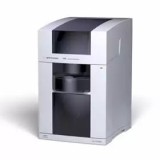
共3台
重组蛋白表征——肽图分析
应用领域
生物产业检测样品
其他检测项目
肽图分析肽图分析是蛋白质鉴定,特别是重组蛋白鉴定的最常用的方法。它通过酶解(一般使用胰蛋白酶)将蛋白质打碎形成肽段,然后以可重现的方式进行肽段的分离和鉴定。肽图分析是一种非常有用的方法,已成为生物技术领域中最有价值的工具之一,它能检测和监控单个氨基酸改变、氧化、去酰胺化,以及其它降解形式。它还能直接检测常见的单克隆抗体修饰变异,如 N 端环化,C 端赖氨酸处理,N- 糖基化,以及内含子表达等非预期的变异。肽图是蛋白质及其酶解产物的指纹图谱,它能提供待测蛋白质的全面信息。肽图分析包含四个主要步骤,蛋白质的分离和纯化;肽键的选择性酶切;多肽的色谱分离;多肽的分析和鉴定。对测试样品与参考标准品或对照样品进行同步的酶解和分析。肽图应该包括足够数量的肽段以进行有效的分析;它不仅要提供蛋白质鉴定所需的必要信息,还应尽可能地涵盖完整的蛋白质序列。

共2台
重组蛋白表征——完整蛋白质的鉴定、纯度和杂质分析
应用领域
生物产业检测样品
其他检测项目
鉴定、纯度和杂质尽管蛋白质生物制品总体来说是相对稳定的分子,但是在生产、制剂和储存过程中,还是会发生一些化学修饰和降解反应。许多蛋白质在纯化过程中可能发生水解断裂,而断裂形成的片段污染物可能会导致患者免疫反应的不良后果。由于存在化学修饰和降解反应,因此需要可靠而且灵敏的方法来评价研发和生产过程中蛋白质的纯度和结构完整性。 完整蛋白质、完整亚基或结构域的精确质量测定对于蛋白质序列组成的快速确认和翻译后修饰、降解和样品处理引起的分子变异的鉴定非常有帮助。电泳、色谱和质谱 (MS) 技术是完整蛋白质及其降解物分子量测定的最常用技术。其中一种最常用的分析是体积排阻色谱 (SEC),它用于测定蛋白质是否为单体结构,并且在生产和制剂过程中是否始终保持这一结构。

共4台
安捷伦科技 2D-LC/MS 在线脱盐技术在药物杂质鉴定中的应用——蛋白质
应用领域
生物产业检测样品
其他检测项目
杂质在液相色谱方法的开发中,常会用到一些添加剂以提高色谱行为表现,但是这些添加剂经常无法兼容质谱检测,而在某些分析中,如杂质分析、代谢分析等,经常需要对某些新产生的杂质或代谢产物进行质谱鉴定,同时又不希望改变方法选择性以便通过保留时间对未知物进行定性。但是如果将原有方法中不能兼容质谱条件的添加剂改变的话,很可能造成选择性变化,从而无法定位欲分析的未知化合物的位置。针对此类问题,安捷伦开发了一个基于阀切换的 2D-LC 方法,保证了在各个色谱峰的保留行为不发生变化的情况下(即原始色谱条件不变),通过二维液相的方式将原始条件中的质谱不兼容流动相变为兼容流动相,从而实现用液质联用方法对未知杂质进行定量分析的目的。
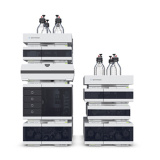
共2台
采用Poroshell 120色谱柱快速分析重组单克隆抗体肽图
应用领域
生物产业检测样品
其他检测项目
肽图肽图是用于对蛋白质药物一级结构进行鉴定以及检测蛋白质产品批间一致性的常规检测方法。一般进行肽图谱鉴别时往往需要时间较长,如重组人胰岛素肽图测定在中国药典、美国药典、欧洲药典中均采用反相HPLC法,检测时间长达60~86min不等;本公司的重组单克隆抗体肽图的检 测时间也长达52分钟。目前的方法中使用的常规液相色谱仪和液相分析柱,分析时间长,且有机试剂耗用量大,快速液相色谱仪和快速液相分析柱的应运而生,使得分析时间和试剂耗量大大降低。但针对目前基层实验室常规液相色谱仪的普及,与快速液相分析柱的不兼容性,使得快速分析检测很难实现。安捷伦公司最新推出的Poroshell 120系列表面多孔层色谱柱,由于其具有低反压,高柱效的特点,从而真正实现在常规液相色谱仪上进行快速分析的可操作性。本文使用Poroshell 120色谱柱,并采用常规液相色谱仪,对重组单克隆抗体肽图检测方法加以改进,分析时间和试剂耗量均降低了1/2以上,一次分析仅需26分钟;色谱峰的理论塔板数及分离度也优于常规检测方法。
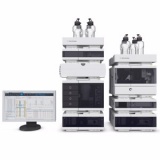
共1台
使用 Agilent Poroshell 120 色谱柱最大限度地提高柱效——应用串联色谱柱技术,5 min 内理论板数可达 100000
应用领域
生物产业检测样品
其他检测项目
提高柱效基于表面多孔技术的色谱柱可替代亚 2 µm 颗粒色谱柱。配备这些色谱柱的 Agilent 1290 Infinity LC 系统可实现高效分离。Agilent Poroshell 120 色谱柱可提供: • 较低的反压 • 最高的柱效 • 可观的柱容量

共1台
将中国药典测定胰岛素的方法转换为使用 Agilent Poroshell 120 色谱柱的方法
应用领域
生物产业检测样品
其他检测项目
合规分析中国药典(Ch. P)规定的检验胰岛素的方法需使用传统的 4.6 × 150 mm 或 4.6 × 250 mm,5 µm 的 C18 液相色谱柱。这两种柱长的传统 5 µm 填料色谱柱的胰岛素峰柱效都很低。本应用报告采用 Agilent Poroshell 120 EC-C18 色谱柱或 Agilent Poroshell 120 SB-C18 色谱柱取代传统的色谱柱进行胰岛素分析。采用 Poroshell 120 色谱柱后调整的方法显著提高了柱效和分离度,并且仍满足 Ch. P 或美国药典(USP)规定方法的要求。

共1台
采用安捷伦 2200 TapeStation 系统进行 RNA 质量控制 – RINe 质量指标的评价
应用领域
生物产业检测样品
其他检测项目
质量控制本应用简报描述了安捷伦 2200 TapeStation 系统与安捷伦 2100 生物分析仪间的性能比较及基准,后者是 RNA 质量控制的行业标准。2200 TapeStation 系统可对最多 96 个样品进行自动化分析,每个样品的分析时间约为 1 分钟。本应用简报展示了 2200 TapeStation 系统生成的 RINe 与 2100 生物分析仪的 RIN 质量评估之间的高度相关性。此外还展示了 2200 TapeStation 系统在 RNA 质量评估中所得 RINe 的高度重现性。 因此,2200 TapeStation 系统是可靠的 RNA 质量控制系统。

共1台
利用 Agilent 2200 TapeStation 系统为新一代测序文库制备及 SureSelect 靶向 序列捕获进行全程样品质量控制
应用领域
生物产业检测样品
其他检测项目
DNA 测序Agilent 2200 TapeStation 系统可对新一代测序 (NGS) 工作流程中的样品进行全程分析,从最初的起始材料一直到测序前的最终 DNA 文库质量控制 (QC)。本应用简报遵循 SureSelect 文库制备实验方案,展示了基因组 DNA ScreenTape、D1000 ScreenTape 及高灵敏度 D1000 ScreenTape 分析方法对该工作流程中样品的分析性能及适用性。数据证明了 2200 TapeStation 系统是可靠的文库分子量测定及定量分析 QC 平台。数据还证明了这些 DNA ScreenTape 分析方法与 Agilent 2100 生物分析仪的相应分析方法具有可比性,并在其性能指标内。

共1台
体积排阻色谱工作流程——AGILENT BIO SEC-3 和 BIO SEC-5 HPLC 色谱柱
应用领域
生物产业检测样品
其他检测项目
蛋白质安捷伦应用化学家将在本文中与您共享有关最佳液相色谱系统及其生物分子表征配置方面的建议。他们还将为您提供通用方法的相关入门指导以及如何就满足特定分离需求而进一步优化方法的相关指导。如需了解更多应用信息,请访问安捷伦官方网站。
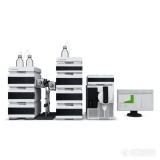
共1台
通过毛细管 HPLC-ICP-MS 分析微升体积的植物汁液中锌的形态
应用领域
生物产业检测样品
生物农业检测项目
锌的形态许多金属元素对于正常的植物生长和发育非常重要。其中一种金属元 素就是锌,它通常是生物体中第二丰富的过渡金属,并且作为重要的 微量营养元素在植物生理学中发挥着不同的作用。锌是 300 多种酶的主要成分。它负责基因调控和蛋白质结构的稳定,包括锌指、锌簇和 RING 指结构域。锌还参与光合作用和 CO2 固定等基本过程。植物中的锌过量或缺乏将导致植物死亡率高、生长迟缓和萎缩、萎黄病、坏 死、小叶病和开花延迟。所有这些症状都可能对食品安全产生严重影响,因为与锌可利用性相关的作物产量将显著降低。本研究提出一种 ICP-MS 辅助的金属组学方法用于分离豌豆后韧皮部中存在的锌形态分析。通过具有在线预浓缩功能的毛细管 HPLC-ICP-MS 对胚囊液体进行分析。由于植物汁液量非常少,所以需要使用毛细管色谱。

暂无关联产品
采用 Agilent 8800/8900 串联四极杆 ICP-MS 通过 capLC-ICP-MS 同时测定多肽和磷酸肽
应用领域
生物产业检测样品
其他检测项目
磷和硫结合毛细管液相色谱分离技术,Agilent 8800 串联四极杆 ICP-MS 在 MS/MS 质量 转移模式下可痕量测定磷酸肽中的磷与含硫多肽中的硫。使用 LC-ICP-MS 可获得前所未有的含硫和含磷物质的最低绝对检测限(分别为 11 fmol 和 6.6 fmol)。 硫的同位素比值测定结果与其理论值高度吻合,从而证明干扰得以有效消除。 所观测到的硫和磷的峰形和信噪比表现优异。测定结果表明串联四极杆capLCICP-MS 技术在使用非特殊标样测定含硫和含磷多肽的高灵敏度和同时绝对定量分析方面有巨大潜力。

暂无关联产品
使用安捷伦 LC/Q-TOF 和 Mass MetaSite 软件无缝鉴定代谢物
应用领域
生物产业检测样品
其他检测项目
代谢物Agilent 1290 Infinity LC 系统可实现优异的色谱分离,Agilent 6550 Q-TOF 提供了高分辨率精确质量 MS/MS 数据。 此外,Mass MetaSite 软件非常有助于系统、可靠地鉴定代谢物结构。
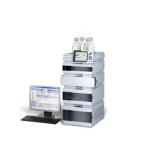
共1台
RNA 完整值 (RIN) — RNA 质量控制标准化
应用领域
生物产业检测样品
其他检测项目
RNA完整性设计出的 RIN 工具一款能够比核糖体比率更好评估 RNA 质量的软件算法。研究者不再受困于总 RNA 的主观分类。通过进行关联实验,可创建阈值以确保实验的重复性。已经发现 RIN 工具基本上没有仪器变异性及浓度变异性,因此有助于仪器间及实验室间样品的比较。

共1台
利用未衍生化氨基酸的 LC/MS 分析进行生物反应器细胞培养监测
应用领域
生物产业检测样品
生物农业检测项目
其他本应用简报介绍了发酵培养基中氨基酸 LC/MS 分析的解决方案。氨基酸的极性使其 难以进行反相液相色谱分析,因此通常使用衍生化来改善其保留能力。然而,亲水 相互作用色谱 (HILIC) 无需衍生化也能保留并分离复杂的氨基酸混合物,同时还具有与传统反相液相色谱类似的工作流程。HILIC 与质谱的组合提供了一种极其简单而功 能强大的未衍生化氨基酸分析解决方案。

共2台
使用 Agilent 5100 同步垂直双向观测 ICP OES 对植物营养元素Al进行分析
应用领域
生物产业检测样品
其他检测项目
Al元素The determination of the elemental composition in plants is important for development, growth and maintenance of plant tissues. Elements, such as Al, B, Ba, Ca, Cu, Fe, K, Mg, Mn, S, Sr, P, and Zn, are important for plant nutrition, being vital nutrients required for tissue development, maintenance and plant metabolism [1]. The determination of macro, micronutrients and contaminants in plant samples is important to keep up with sources of nutrients and minerals. The chemical analysis of plant materials can be applied to assist in the remediation of contaminated soils or to solve mineral malnutrition, a problem that seriously affects the human population [2, 3]. Inductively coupled plasma optical emission spectrometry (ICP-OES) is an attractive technique for this analysis because it can accommodate the wide concentration ranges typical of macro and micronutrients in plants. 2 Agronomical laboratories typically deal with large batches of samples. Several critical elements, in wide concentration ranges, must be determined on a routine basis for such samples. The Agilent 5100 Synchronous Vertical Dual View (SVDV) ICP-OES with Dichroic Spectral Combiner (DSC) technology, has the ability to keep up with these demands, performing axial and radial measurements in a single reading, leading to faster sample throughput times. With faster sample run times, the 5100 SVDV requires less argon per sample, meaning significant savings can be made for labs involved in high throughput analysis. The Vista Chip II detector used in the 5100 ICP-OES has the fastest processing speed (1 MHz) of any charge coupled device (CCD) detector used in ICP-OES. It delivers fast warm-up, high throughput, high sensitivity, and the largest dynamic range. This application note describes the quantitation of Al, B, Ba, Ca, Cu, Fe, K, Mg, Mn, P, S, Sr and Zn in microwave acid digested alfalfa, corn and sugarcane samples and an apple leaves certified reference material (SRM NIST 1515), using the Agilent 5100

暂无关联产品
使用 Agilent 5100 同步垂直双向观测 ICP OES 对植物营养元素B进行分析
应用领域
生物产业检测样品
其他检测项目
B元素The determination of the elemental composition in plants is important for development, growth and maintenance of plant tissues. Elements, such as Al, B, Ba, Ca, Cu, Fe, K, Mg, Mn, S, Sr, P, and Zn, are important for plant nutrition, being vital nutrients required for tissue development, maintenance and plant metabolism [1]. The determination of macro, micronutrients and contaminants in plant samples is important to keep up with sources of nutrients and minerals. The chemical analysis of plant materials can be applied to assist in the remediation of contaminated soils or to solve mineral malnutrition, a problem that seriously affects the human population [2, 3]. Inductively coupled plasma optical emission spectrometry (ICP-OES) is an attractive technique for this analysis because it can accommodate the wide concentration ranges typical of macro and micronutrients in plants. 2 Agronomical laboratories typically deal with large batches of samples. Several critical elements, in wide concentration ranges, must be determined on a routine basis for such samples. The Agilent 5100 Synchronous Vertical Dual View (SVDV) ICP-OES with Dichroic Spectral Combiner (DSC) technology, has the ability to keep up with these demands, performing axial and radial measurements in a single reading, leading to faster sample throughput times. With faster sample run times, the 5100 SVDV requires less argon per sample, meaning significant savings can be made for labs involved in high throughput analysis. The Vista Chip II detector used in the 5100 ICP-OES has the fastest processing speed (1 MHz) of any charge coupled device (CCD) detector used in ICP-OES. It delivers fast warm-up, high throughput, high sensitivity, and the largest dynamic range. This application note describes the quantitation of Al, B, Ba, Ca, Cu, Fe, K, Mg, Mn, P, S, Sr and Zn in microwave acid digested alfalfa, corn and sugarcane samples and an apple leaves certified reference material (SRM NIST 1515), using the Agilent 5100

暂无关联产品
使用 Agilent 5100 同步垂直双向观测 ICP OES 对植物营养元素Ba进行分析
应用领域
生物产业检测样品
其他检测项目
Ba元素The determination of the elemental composition in plants is important for development, growth and maintenance of plant tissues. Elements, such as Al, B, Ba, Ca, Cu, Fe, K, Mg, Mn, S, Sr, P, and Zn, are important for plant nutrition, being vital nutrients required for tissue development, maintenance and plant metabolism [1]. The determination of macro, micronutrients and contaminants in plant samples is important to keep up with sources of nutrients and minerals. The chemical analysis of plant materials can be applied to assist in the remediation of contaminated soils or to solve mineral malnutrition, a problem that seriously affects the human population [2, 3]. Inductively coupled plasma optical emission spectrometry (ICP-OES) is an attractive technique for this analysis because it can accommodate the wide concentration ranges typical of macro and micronutrients in plants. 2 Agronomical laboratories typically deal with large batches of samples. Several critical elements, in wide concentration ranges, must be determined on a routine basis for such samples. The Agilent 5100 Synchronous Vertical Dual View (SVDV) ICP-OES with Dichroic Spectral Combiner (DSC) technology, has the ability to keep up with these demands, performing axial and radial measurements in a single reading, leading to faster sample throughput times. With faster sample run times, the 5100 SVDV requires less argon per sample, meaning significant savings can be made for labs involved in high throughput analysis. The Vista Chip II detector used in the 5100 ICP-OES has the fastest processing speed (1 MHz) of any charge coupled device (CCD) detector used in ICP-OES. It delivers fast warm-up, high throughput, high sensitivity, and the largest dynamic range. This application note describes the quantitation of Al, B, Ba, Ca, Cu, Fe, K, Mg, Mn, P, S, Sr and Zn in microwave acid digested alfalfa, corn and sugarcane samples and an apple leaves certified reference material (SRM NIST 1515), using the Agilent 5100

暂无关联产品
使用 Agilent 5100 同步垂直双向观测 ICP OES 对植物营养元素Ca进行分析
应用领域
生物产业检测样品
其他检测项目
Ca元素The determination of the elemental composition in plants is important for development, growth and maintenance of plant tissues. Elements, such as Al, B, Ba, Ca, Cu, Fe, K, Mg, Mn, S, Sr, P, and Zn, are important for plant nutrition, being vital nutrients required for tissue development, maintenance and plant metabolism [1]. The determination of macro, micronutrients and contaminants in plant samples is important to keep up with sources of nutrients and minerals. The chemical analysis of plant materials can be applied to assist in the remediation of contaminated soils or to solve mineral malnutrition, a problem that seriously affects the human population [2, 3]. Inductively coupled plasma optical emission spectrometry (ICP-OES) is an attractive technique for this analysis because it can accommodate the wide concentration ranges typical of macro and micronutrients in plants. 2 Agronomical laboratories typically deal with large batches of samples. Several critical elements, in wide concentration ranges, must be determined on a routine basis for such samples. The Agilent 5100 Synchronous Vertical Dual View (SVDV) ICP-OES with Dichroic Spectral Combiner (DSC) technology, has the ability to keep up with these demands, performing axial and radial measurements in a single reading, leading to faster sample throughput times. With faster sample run times, the 5100 SVDV requires less argon per sample, meaning significant savings can be made for labs involved in high throughput analysis. The Vista Chip II detector used in the 5100 ICP-OES has the fastest processing speed (1 MHz) of any charge coupled device (CCD) detector used in ICP-OES. It delivers fast warm-up, high throughput, high sensitivity, and the largest dynamic range. This application note describes the quantitation of Al, B, Ba, Ca, Cu, Fe, K, Mg, Mn, P, S, Sr and Zn in microwave acid digested alfalfa, corn and sugarcane samples and an apple leaves certified reference material (SRM NIST 1515), using the Agilent 5100

暂无关联产品
使用 Agilent 5100 同步垂直双向观测 ICP OES 对植物营养元素Cu进行分析
应用领域
生物产业检测样品
其他检测项目
Cu元素The determination of the elemental composition in plants is important for development, growth and maintenance of plant tissues. Elements, such as Al, B, Ba, Ca, Cu, Fe, K, Mg, Mn, S, Sr, P, and Zn, are important for plant nutrition, being vital nutrients required for tissue development, maintenance and plant metabolism [1]. The determination of macro, micronutrients and contaminants in plant samples is important to keep up with sources of nutrients and minerals. The chemical analysis of plant materials can be applied to assist in the remediation of contaminated soils or to solve mineral malnutrition, a problem that seriously affects the human population [2, 3]. Inductively coupled plasma optical emission spectrometry (ICP-OES) is an attractive technique for this analysis because it can accommodate the wide concentration ranges typical of macro and micronutrients in plants. 2 Agronomical laboratories typically deal with large batches of samples. Several critical elements, in wide concentration ranges, must be determined on a routine basis for such samples. The Agilent 5100 Synchronous Vertical Dual View (SVDV) ICP-OES with Dichroic Spectral Combiner (DSC) technology, has the ability to keep up with these demands, performing axial and radial measurements in a single reading, leading to faster sample throughput times. With faster sample run times, the 5100 SVDV requires less argon per sample, meaning significant savings can be made for labs involved in high throughput analysis. The Vista Chip II detector used in the 5100 ICP-OES has the fastest processing speed (1 MHz) of any charge coupled device (CCD) detector used in ICP-OES. It delivers fast warm-up, high throughput, high sensitivity, and the largest dynamic range. This application note describes the quantitation of Al, B, Ba, Ca, Cu, Fe, K, Mg, Mn, P, S, Sr and Zn in microwave acid digested alfalfa, corn and sugarcane samples and an apple leaves certified reference material (SRM NIST 1515), using the Agilent 5100

暂无关联产品
使用 Agilent 5100 同步垂直双向观测 ICP OES 对植物营养元素Fe进行分析
应用领域
生物产业检测样品
其他检测项目
Fe元素The determination of the elemental composition in plants is important for development, growth and maintenance of plant tissues. Elements, such as Al, B, Ba, Ca, Cu, Fe, K, Mg, Mn, S, Sr, P, and Zn, are important for plant nutrition, being vital nutrients required for tissue development, maintenance and plant metabolism [1]. The determination of macro, micronutrients and contaminants in plant samples is important to keep up with sources of nutrients and minerals. The chemical analysis of plant materials can be applied to assist in the remediation of contaminated soils or to solve mineral malnutrition, a problem that seriously affects the human population [2, 3]. Inductively coupled plasma optical emission spectrometry (ICP-OES) is an attractive technique for this analysis because it can accommodate the wide concentration ranges typical of macro and micronutrients in plants. 2 Agronomical laboratories typically deal with large batches of samples. Several critical elements, in wide concentration ranges, must be determined on a routine basis for such samples. The Agilent 5100 Synchronous Vertical Dual View (SVDV) ICP-OES with Dichroic Spectral Combiner (DSC) technology, has the ability to keep up with these demands, performing axial and radial measurements in a single reading, leading to faster sample throughput times. With faster sample run times, the 5100 SVDV requires less argon per sample, meaning significant savings can be made for labs involved in high throughput analysis. The Vista Chip II detector used in the 5100 ICP-OES has the fastest processing speed (1 MHz) of any charge coupled device (CCD) detector used in ICP-OES. It delivers fast warm-up, high throughput, high sensitivity, and the largest dynamic range. This application note describes the quantitation of Al, B, Ba, Ca, Cu, Fe, K, Mg, Mn, P, S, Sr and Zn in microwave acid digested alfalfa, corn and sugarcane samples and an apple leaves certified reference material (SRM NIST 1515), using the Agilent 5100

暂无关联产品
使用 Agilent 5100 同步垂直双向观测 ICP OES 对植物营养元素K进行分析
应用领域
生物产业检测样品
其他检测项目
K元素The determination of the elemental composition in plants is important for development, growth and maintenance of plant tissues. Elements, such as Al, B, Ba, Ca, Cu, Fe, K, Mg, Mn, S, Sr, P, and Zn, are important for plant nutrition, being vital nutrients required for tissue development, maintenance and plant metabolism [1]. The determination of macro, micronutrients and contaminants in plant samples is important to keep up with sources of nutrients and minerals. The chemical analysis of plant materials can be applied to assist in the remediation of contaminated soils or to solve mineral malnutrition, a problem that seriously affects the human population [2, 3]. Inductively coupled plasma optical emission spectrometry (ICP-OES) is an attractive technique for this analysis because it can accommodate the wide concentration ranges typical of macro and micronutrients in plants. 2 Agronomical laboratories typically deal with large batches of samples. Several critical elements, in wide concentration ranges, must be determined on a routine basis for such samples. The Agilent 5100 Synchronous Vertical Dual View (SVDV) ICP-OES with Dichroic Spectral Combiner (DSC) technology, has the ability to keep up with these demands, performing axial and radial measurements in a single reading, leading to faster sample throughput times. With faster sample run times, the 5100 SVDV requires less argon per sample, meaning significant savings can be made for labs involved in high throughput analysis. The Vista Chip II detector used in the 5100 ICP-OES has the fastest processing speed (1 MHz) of any charge coupled device (CCD) detector used in ICP-OES. It delivers fast warm-up, high throughput, high sensitivity, and the largest dynamic range. This application note describes the quantitation of Al, B, Ba, Ca, Cu, Fe, K, Mg, Mn, P, S, Sr and Zn in microwave acid digested alfalfa, corn and sugarcane samples and an apple leaves certified reference material (SRM NIST 1515), using the Agilent 5100

暂无关联产品
使用 Agilent 5100 同步垂直双向观测 ICP OES 对植物营养元素Mg进行分析
应用领域
生物产业检测样品
其他检测项目
Mg元素The determination of the elemental composition in plants is important for development, growth and maintenance of plant tissues. Elements, such as Al, B, Ba, Ca, Cu, Fe, K, Mg, Mn, S, Sr, P, and Zn, are important for plant nutrition, being vital nutrients required for tissue development, maintenance and plant metabolism [1]. The determination of macro, micronutrients and contaminants in plant samples is important to keep up with sources of nutrients and minerals. The chemical analysis of plant materials can be applied to assist in the remediation of contaminated soils or to solve mineral malnutrition, a problem that seriously affects the human population [2, 3]. Inductively coupled plasma optical emission spectrometry (ICP-OES) is an attractive technique for this analysis because it can accommodate the wide concentration ranges typical of macro and micronutrients in plants. 2 Agronomical laboratories typically deal with large batches of samples. Several critical elements, in wide concentration ranges, must be determined on a routine basis for such samples. The Agilent 5100 Synchronous Vertical Dual View (SVDV) ICP-OES with Dichroic Spectral Combiner (DSC) technology, has the ability to keep up with these demands, performing axial and radial measurements in a single reading, leading to faster sample throughput times. With faster sample run times, the 5100 SVDV requires less argon per sample, meaning significant savings can be made for labs involved in high throughput analysis. The Vista Chip II detector used in the 5100 ICP-OES has the fastest processing speed (1 MHz) of any charge coupled device (CCD) detector used in ICP-OES. It delivers fast warm-up, high throughput, high sensitivity, and the largest dynamic range. This application note describes the quantitation of Al, B, Ba, Ca, Cu, Fe, K, Mg, Mn, P, S, Sr and Zn in microwave acid digested alfalfa, corn and sugarcane samples and an apple leaves certified reference material (SRM NIST 1515), using the Agilent 5100

暂无关联产品
使用 Agilent 5100 同步垂直双向观测 ICP OES 对植物营养元素 Mn进行分析
应用领域
生物产业检测样品
其他检测项目
Mn元素The determination of the elemental composition in plants is important for development, growth and maintenance of plant tissues. Elements, such as Al, B, Ba, Ca, Cu, Fe, K, Mg, Mn, S, Sr, P, and Zn, are important for plant nutrition, being vital nutrients required for tissue development, maintenance and plant metabolism [1]. The determination of macro, micronutrients and contaminants in plant samples is important to keep up with sources of nutrients and minerals. The chemical analysis of plant materials can be applied to assist in the remediation of contaminated soils or to solve mineral malnutrition, a problem that seriously affects the human population [2, 3]. Inductively coupled plasma optical emission spectrometry (ICP-OES) is an attractive technique for this analysis because it can accommodate the wide concentration ranges typical of macro and micronutrients in plants. 2 Agronomical laboratories typically deal with large batches of samples. Several critical elements, in wide concentration ranges, must be determined on a routine basis for such samples. The Agilent 5100 Synchronous Vertical Dual View (SVDV) ICP-OES with Dichroic Spectral Combiner (DSC) technology, has the ability to keep up with these demands, performing axial and radial measurements in a single reading, leading to faster sample throughput times. With faster sample run times, the 5100 SVDV requires less argon per sample, meaning significant savings can be made for labs involved in high throughput analysis. The Vista Chip II detector used in the 5100 ICP-OES has the fastest processing speed (1 MHz) of any charge coupled device (CCD) detector used in ICP-OES. It delivers fast warm-up, high throughput, high sensitivity, and the largest dynamic range. This application note describes the quantitation of Al, B, Ba, Ca, Cu, Fe, K, Mg, Mn, P, S, Sr and Zn in microwave acid digested alfalfa, corn and sugarcane samples and an apple leaves certified reference material (SRM NIST 1515), using the Agilent 5100

暂无关联产品
使用 Agilent 5100 同步垂直双向观测 ICP OES 对植物营养元素S进行分析
应用领域
生物产业检测样品
其他检测项目
S元素The determination of the elemental composition in plants is important for development, growth and maintenance of plant tissues. Elements, such as Al, B, Ba, Ca, Cu, Fe, K, Mg, Mn, S, Sr, P, and Zn, are important for plant nutrition, being vital nutrients required for tissue development, maintenance and plant metabolism [1]. The determination of macro, micronutrients and contaminants in plant samples is important to keep up with sources of nutrients and minerals. The chemical analysis of plant materials can be applied to assist in the remediation of contaminated soils or to solve mineral malnutrition, a problem that seriously affects the human population [2, 3]. Inductively coupled plasma optical emission spectrometry (ICP-OES) is an attractive technique for this analysis because it can accommodate the wide concentration ranges typical of macro and micronutrients in plants. 2 Agronomical laboratories typically deal with large batches of samples. Several critical elements, in wide concentration ranges, must be determined on a routine basis for such samples. The Agilent 5100 Synchronous Vertical Dual View (SVDV) ICP-OES with Dichroic Spectral Combiner (DSC) technology, has the ability to keep up with these demands, performing axial and radial measurements in a single reading, leading to faster sample throughput times. With faster sample run times, the 5100 SVDV requires less argon per sample, meaning significant savings can be made for labs involved in high throughput analysis. The Vista Chip II detector used in the 5100 ICP-OES has the fastest processing speed (1 MHz) of any charge coupled device (CCD) detector used in ICP-OES. It delivers fast warm-up, high throughput, high sensitivity, and the largest dynamic range. This application note describes the quantitation of Al, B, Ba, Ca, Cu, Fe, K, Mg, Mn, P, S, Sr and Zn in microwave acid digested alfalfa, corn and sugarcane samples and an apple leaves certified reference material (SRM NIST 1515), using the Agilent 5100

暂无关联产品
安捷伦 Cary 60 紫外-可见分光光度计配 置微光纤探头测定4°C下微量DNA的纯度
应用领域
生物产业检测样品
其他检测项目
纯度安捷伦 Cary 60 紫外-可见分光光度计是在储存环境(如冰箱)下直接测定微量生物样品的理想仪器。本应用报告展示了如何使用 Cary 60 及其微光纤探头附件测定 4 °C 下的 DNA 纯度——结果表明,使用该仪器能够大幅节省时间和成本,同时数据精确度和重现性毫无损失。

共2台







